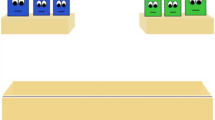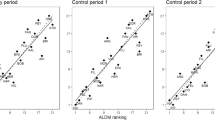Abstract
Previous research has shown a relationship between glancing and dominance in a variety of primate species. In these species, subordinate animals glance more frequently and dominant animals are more frequently the object of glances. In the present study, 30 children in two nursery school classes were observed to determine dominance relationships. The dominance hierarchies obtained by observation were highly correlated with rankings of relative dominance by the classroom teachers. The children were then observed for frequency of glancing along with the object of each glance. It was found that the relationship between glancing and dominance for these preschool children was highly similar to the relationships reported for infrahuman primates.
Similar content being viewed by others
References
ALTMAN, S. 1967. The structure of primate social communication. In S. Altman (Ed.), Social communication among primates. Chicago: University of Chicago Press.
BLURTON JONES, N. G. 1972. Non-verbal communication in children. In R. A. Hinde (Ed.), Non-verbal communication. Cambridge: Cambridge University Press.
BRANIGAN, C. R., & HUMPHRIES, D. A. 1972. Human non-verbal communication. In N. G. Blurton Jones (Ed.), Ethological studies of child behaviour. Cambridge: Cambridge University Press.
EFRAN, J. S. 1968. Looking for approval: Effects of visual behavior on approbation from persons differing in importance. Journal of Personality and Social Psychology, 10, 21–25.
EXLINE, R. V. 1971. Visual interaction: The glances of power and preference. In Nebraska Symposium on Motivation (Vol. 19). Lincoln: University of Nebraska Press.
HALL, K. R. 1967. Social interactions of the adult male and adult females of a patas monkey group. In S. Altman (Ed.), Social communication among primates. Chicago: University of Chicago Press.
HALL, K. R. 1968. Social organization of the Old World monkeys and apes. In P. Jay (Ed.), Primates: Studies in adaptation and variability. New York: Holt, Rinehart & Winston.
HALL, K. R., & DEVORE, I. 1965. Baboon social behavior. In I. Devore (Ed.), Primate behavior: Field studies of monkeys and apes. New York: Holt, Rinehart & Winston.
HEARN, G. 1957. Leadership and the spatial factor in small groups. Journal of Abnormal and Social Psychology, 54, 269–272.
McGREW, W. C. 1969. An ethological study of agnostic behaviour in preschool children. In C. R. Carpenter (Ed.), Behavior: Proceedings of the second international congress of primatology. Zurich: Karger.
McGREW, W. C. 1972. Aspects of social development in nursery school children with emphasis on introduction to the group. In N. G. Blurton Jones (Ed.), Ethological studies of child behaviour. Cambridge: Cambridge University Press.
MEHRABIAN, A. 1972. Nonverbal communication. Chicago: Aldine-Atherton.
MILLER, R. E. 1967. Experimental approaches to the physiological and behavioral concomitants of affective communication in rhesus monkeys. In S. Altman (Ed.), Social communication among primates. Chicago: University of Chicago Press.
SIMONDS, P. 1965. The Bonnet Macaque in South Africa. In I. Devore (Ed.), Primate behavior: Field studies of monkeys and apes. New York: Holt, Rinehart & Winston.
SMITH, P. R., & CONNOLLY, K. 1972. Patterns of play and social interaction in pre-school children. In N. G. Blurton Jones (Ed.), Ethological studies of child behaviour. Cambridge: Cambridge University Press.
THAYER, S. 1969. The effect of interpersonal looking duration on dominance judgments. Journal of Social Psychology, 79, 285–286.
Author information
Authors and Affiliations
Rights and permissions
About this article
Cite this article
Anderson, F.J., Willis, F.N. Glancing at Others in Preschool Children in Relation to Dominance. Psychol Rec 26, 467–472 (1976). https://doi.org/10.1007/BF03394412
Published:
Issue Date:
DOI: https://doi.org/10.1007/BF03394412




